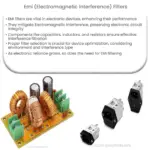Explore the vital role of EMI/RFI filters in electronic circuit design, their types, components, and importance in ensuring device reliability.

Introduction to EMI/RFI Filters
Electromagnetic Interference (EMI) and Radio Frequency Interference (RFI) are significant challenges in electronic circuit design. These phenomena can disrupt proper functioning, degrade performance, and even damage electronic systems. Hence, a critical component called EMI/RFI filters is used to manage and mitigate these issues.
Understanding EMI/RFI
Before we delve into filters, it’s important to understand what EMI and RFI are. EMI is a disturbance generated by an external source that affects an electrical circuit through electromagnetic induction or electrostatic coupling. RFI, a subset of EMI, specifically refers to interference caused by devices emitting radio frequency energy.
EMI/RFI Filters: A Vital Solution
EMI/RFI filters are essential tools designed to prevent or minimize EMI and RFI from entering or exiting electronic devices. These filters are made up of components that absorb or reflect unwanted interference, allowing only the desired signals to pass through. By attenuating the interference, they improve the performance and reliability of electronic systems.
Types of EMI/RFI Filters
- Power Line Filters: These filters reduce EMI from power lines and are typically used in appliances, industrial machinery, and computers.
- Data Line Filters: Data line filters target EMI in data and signal lines, particularly crucial in telecommunications and data transmission.
- RFI Filters: Specifically designed for radio frequency interference, these filters are used in communication and broadcasting devices.
The Importance of EMI/RFI Filters in Circuit Design
The prevalence of electronic devices in our day-to-day lives has increased the potential sources of EMI and RFI. These disturbances can cause malfunctions, data errors, and system failures, severely impacting the reliability and functionality of electronic systems. Consequently, EMI/RFI filters have become an integral part of circuit design, protecting the systems from unwanted disturbances and ensuring optimal performance.
How EMI/RFI Filters Work
At a high level, EMI/RFI filters work by grounding the unwanted signals, which are then dissipated as heat. They do this by using a combination of capacitors and inductors, each addressing different frequency ranges of interference. The capacitors handle high-frequency signals, while the inductors are designed to deal with lower frequency interference.
Key Components of EMI/RFI Filters
As mentioned before, EMI/RFI filters use capacitors and inductors to handle different frequencies of interference. But what exactly are these components?
- Capacitors: These are passive electronic components that store energy in an electric field. In the context of EMI/RFI filters, capacitors block direct current (DC) while allowing alternating current (AC) to pass, effectively removing the high-frequency interference.
- Inductors: Also known as coils or chokes, inductors are components that store energy in a magnetic field. They are used in EMI/RFI filters to impede changes in current and thereby eliminate low-frequency interference.
Choosing the Right EMI/RFI Filter
Selecting an appropriate EMI/RFI filter is crucial for optimal electronic system performance. Factors to consider include the type and magnitude of the interference, operating frequency, and power requirements of the system, amongst others. Consulting with a professional experienced in electromagnetic compatibility (EMC) can be immensely beneficial in making the right choice.
Regulatory Standards for EMI/RFI
Given the potential damage and disruption that EMI and RFI can cause, regulatory bodies around the world have established standards for electromagnetic compatibility. These standards specify the allowable limits of EMI and RFI emissions from electronic devices, thus ensuring their safe and reliable operation. Compliance with these standards is mandatory for electronic products in many markets, further emphasizing the importance of EMI/RFI filters in circuit design.
Conclusion
EMI/RFI filters play a vital role in modern electronics, ensuring systems function reliably amidst potential electromagnetic and radio frequency interference. With the growing proliferation of electronic devices in our everyday lives, these filters become increasingly crucial. Whether it’s for a simple household appliance or complex industrial machinery, the correct application of EMI/RFI filters can make the difference between a smoothly operating device and one plagued with errors and malfunctions. As technology continues to advance, the design and application of these filters will remain a key focus in electronic circuit design, facilitating the harmonious coexistence of various electronic systems in our interconnected world.



